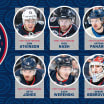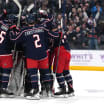At 7:08 a.m., exactly 12 hours before the Blue Jackets will host Vegas on Nov. 5, Ian Huffman is walking the perimeter of the 200-by-85-foot ice surface in Nationwide Arena.
The organization's ice technician has the handle of a Zamboni-made edger in his hands as he scrapes the excess ice from where the playing surface meets the boards. It's step one in a day that will span 16 hours of work, one of 41 times Huffman and his crew will go through the same routine this regular season.
When the puck finally drops, six Blue Jackets players, six Golden Knights and four referees will begin to propel themselves across that surface with pinpoint control at astonishing speeds in razor-sharp blades.
A day in the life of the Nationwide Arena ice
What does it take to get the surface ready for the Blue Jackets? A lot of hard work
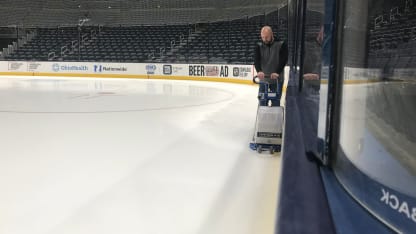
© JEFF SVOBODA/BLUEJACKETS.COM
And just like those players and referees, the ice surface is a living, breathing organism. Without proper care, it will threaten to submarine the quality of the game taking place on top of it; take care of it properly and it will reward in turn.
That's the job Huffman has, and he's excelled at it since taking over as the Blue Jackets' ice guru in 2009. He's earned credibility across the game for producing one of the NHL's best surfaces year in and year out, and he is one of the icemen who joins the crew each year for the league's Winter Classic outdoor game.
His pursuit each day is simple -- providing a high-quality, consistent playing surface for the Blue Jackets and their foes.
"My goal for each day is to try to have the same conditions -- the same ice conditions, bowl conditions -- for each day," Huffman said. "So I'm trying to do the same thing as far as an edging schedule, hand scraping, resurfacing, a safety check on the boards and everything.
"I try to keep that similar each day so that I am giving them the same consistent surface, or consistent as possible, whether it's a practice day or a morning skate."
So, how does that happen? The answer, as it turns out, is a lot of hard work.
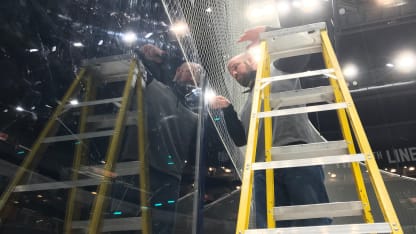
© JEFF SVOBODA/BLUEJACKETS.COM
A Never-Ending Process
Any guesses as to how many times a Zamboni -- the Blue Jackets use two machines produced by the iconic company -- will resurface the Nationwide Arena ice on a game day?
On the Tuesday in question when Columbus welcomed Vegas, the answer is 14.
The Gear Daddies may have penned the unforgettable song about wanting to drive a Zamboni, but Huffman has lived plenty of that life. He's made enough laps around the Nationwide Arena surface to make Richard Petty jealous, so much so that he's passed on driving duties during many games.
On this night, he does take his familiar perch behind the wheel of Zam 1 -- yes, there's even an Ohio license plate affixed to the back with the name -- while Jon Proper, a longtime helping hand and employee of The OhioHealth Chiller ice rinks, takes Zam 2.
That's getting ahead of ourselves a bit, though, so let's back up a bit. The Vegas game came three days after a Saturday night clash with Calgary, so here's how a game in the life of the ice surface plays out.
First, Huffman came in Sunday to clean up the surface and work on removing any ruts and imperfections that came up during the game. The Blue Jackets were off that day, but the team returned to the arena ice Monday for practice. That meant an arrival late in the 6 a.m. hour for Huffman, then about a 12-hour day of work.
While he has to get the ice ready for use on each of these non-game days, there's also a fair amount of ice maintenance that goes on to prep the sheet for when the lights are brightest. That includes making sure the ice is at the thickness he wants based on the arena schedule.
At Nationwide Arena, the ice is typically held at about a thickness of an inch and a quarter, but on an average game day, Huffman will lose about an eighth of an inch of ice from beginning to end. The reason is that new ice is snowier ice, so shaving down a bit means less depth but a better surface when it really matters.
The surface must be built up, then, on the non-game days, and getting the depths of the ice correct is essential, especially in high traffic areas like the goal crease. To that end, Huffman has an infrared sensor that can measure the thickness of the sheet.
"I'll resurface it, then I will come and I'll check some depths because we're going into a gameday tomorrow here," he said of his Monday routine. "There will be a lot of resurfacing, a lot of shaving (Tuesday). You don't necessarily want to put new ice out there on a game day because it creates snowier conditions if it's fresher ice, so we want to try to get all that done beforehand.
"I would say my main focus is getting the crease and the trapezoid area ready, making sure I have plenty there because that's the part we drive over the most, so that's the part where we lose the most ice throughout a game day."

© JEFF SVOBODA/BLUEJACKETS.COM
Game Day Starts Early
Tuesday morning, the on-ice work began when Huffman stepped out with the mechanical edger. Because the Zamboni blade can't quite extend to the spots abutting the boards, the hand-pushed edger gets those hard-to-reach areas, sending the snow shooting back toward the middle of the surface to be collected by the first resurfacing of the day.
That takes place at 7:18 a.m. in a largely empty arena. As daylight starts to break in the windows located atop of the north and south ends of the buildings -- the eyebrows, as they're known in arena parlance -- Huffman backs Zam 2 out of the garage at the southwest corner of the arena, executes a three-point turn and eases the machine onto the ice.
Two more passes will take place in the morning -- one at 8:30, the other at 9:20 -- with the goal of creating the smoothest surface possible, as each route buffers skate marks and other imperfections out of the ice.
In between the first and second resurfacing of the morning, Huffman executes the day's first safety check. He walks a full lap around the border of the rink, checking for screws that might be loose in the boards or any other issues that may arise. Today, that means taking a ladder across the ice to the rink's east end to fix a carabiner clip that attaches the spectator netting to the top of the glass.
From the morning, things settle into a pattern on most game days. Huffman resurfaces after each team's morning skate as well as the midday staff game, and he spends around half an hour during Vegas' practice pulling Zam 1 out of its spot in the garage to change the blade. The 77-inch-long, flat, steel blade cuts at a 27-degree angle and sits in the conditioner at the back of the Zamboni, and Huffman has around 16 of them he rotates through, swapping them out when necessary and sending them for sharpening.
It's all part of the magic of the machine that has enchanted hockey fans for decades. The Zamboni works by shaving off a slim section of the top of the chewed-up ice, collecting the resulting "snow," and then putting down hot, filtered water behind it to replace what has been lost. When that hot water hits, it freezes quickly and smoothly thanks to a glycol cooling system that runs in the cement beneath the rink.
With the blade changed and morning practices done for both the Blue Jackets and Golden Knights, Huffman is able to take a break.
"It's just me here other than during games, so you put in the hours and drink coffee," he said. "It breaks it up that after the morning skates, I have a couple of hours in the afternoons of downtime. I try not to be too busy during that time. Grab lunch, relax a little bit, get a coffee and then 4 o'clock on a gameday, we start to get going."
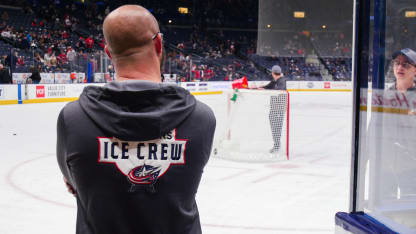
© ANTHONY ALLOCCO/BLUEJACKETS.COM
The Night Begins
Reinforcements on the Boren Brothers Ice Crew will check in as opening faceoff nears. Many, like Proper, have history working in the ice maintenance field, but some have other full-time jobs but are happy to pitch in to help. Huffman oversees the crew, including the 12 members who will don shovels and take to the ice during each of the nine TV timeouts in each game.
Proper is the first in the building, though, and he and Huffman get together around 4 p.m. to start getting the ice ready for the game. Huffman takes the edger around for a lap, then takes the first pass on the Zamboni at 4:13 p.m.
After Huffman pulls the Zamboni off the ice surface and heads for the garage -- honking each time he drives through the tunnel to alert any passersby that he's coming through -- Proper immediately begins pulling off the leftover slush and snow off the ice that the machine leaves at the edge of the ice surface.
As one might imagine given its location, that spot is perhaps the most difficult piece of ice to maintain. Proper pulls the excess snow and water off the ice into a drain that sits just off the ice surface, then grabs a hand scraper -- a six-foot-long tool similar to an inverted shovel with a four-inch long flat blade on the end -- to chip away excess ice that has built up in the corner. Later, ice crew member Brian Ashworth will do a full lap of the rink with the hand scraper, making sure there's no excess buildup along the boards before opening faceoff.
There will be two more passes of the Zamboni before warmups begin, plus another safety check done by longtime arena crew member Tim Parker. A realtor by trade who lives in Lima, Parker has become one of the trusted hands of the crew, overseeing the action in the Zamboni tunnel on game days and serving as "the energy behind the crew" by Huffman.
After warmups, the whole ice crew takes to the surface for the first time to collect warmup pucks and the nets, then both Proper and Huffman hit the ice with the Zambonis for a pregame resurfacing that takes about five minutes. As the warm water the Zamboni places on the surface freezes, the ice settles in at about 21 degrees, right where Huffman wants it. (He says skaters can tell the difference between a sheet that's 20 degrees and one that's 23.)
During the game, there's a serious but laid-back attitude in the tunnel; the ice crew knows what it's doing.
"I have a great crew here, and especially during games, I don't have to do everything myself," Huffman said. "Even though the expectations come from me, I have guys who know exactly what needs to be done to take care of the little things. If something needs addressed at the far end of the rink and I don't see it, those guys are going to take care of it."
Once the game begins, at each media timeout, a ballet of controlled chaos begins. There are just over two minutes during each break to clear the snow off the ice that has accumulated as the players' skates carve up the ice. As the red light goes on at the penalty box area to signify a timeout -- those occur at the first non-icing, even-strength timeout under 14, 10 and six minutes to play in each period -- the 12 members of the Ice Crew working each game sprint onto the surface along with Proper, who takes a temperature reading of the surface.
Eight members of the crew skate the length of the ice twice with shovels to collect up the snow, then leave it near each goal line where four others clear the crease area and then shovel the snow into bins that are wheeled on the ice. In the meantime, Parker oversees the whole operation and pulls off the snow dropped in the corner. It's hectic but under control, considering the crew undertakes each maneuver nine times per game each season.
With 9:22 left in the second period on this night, the cleaning feels a little more hectic than normal. The timeout kicks off just as a scrum is developing near the Blue Jackets' net after a Golden Knights player ran into CBJ goalie Joonas Korpisalo, sending him flying to the ice. "Send 'em," Huffman says as the crew takes to the ice, while Parker grabs a towel to wipe off beads of water from the glass that got covered by the hard-stopping Pierre-Luc Dubois.
It's also at this time, the second media timeout of the period, that Huffman will start the glycol ice plant to begin shooting coolant into the pipes that run below the ice. He does that from an iPad he carries with him, which has the controls to the plant as well as an interface that shows the ice plant conditions, temperatures throughout the building and much, much more.
"He's like an indoor weatherman," Parker said of Huffman.
The NHL also requires a series of forms to be filled out each day on such factors as ice temperature, arena temperature and more, all part of an effort to ensure the quality of each sheet across the league. Of particular attention to the league is the six feet on the ice between each post, where a video review of whether a puck crossed the line can be the difference between a win and a loss.
As the game continues, there are few issues on this night. Pucks largely bounce true, and without a ton of humidity in the air, there's no need to worry it softening up or turning soupy throughout the night.
Once the game ends, the cycle begins once more. The ice sees a Zamboni right after the game, plus a pass from the edger, and Huffman does one final resurfacing before leaving around 11:30.
Having provided the ice surface the team wants and deserves, he'll head home for some hard-earned rest. There won't be a home game day for 10 days, and the ice will be covered for events in the arena for much of that time.
When the team returns from a seven-day road trip, Huffman will do it all over again.







